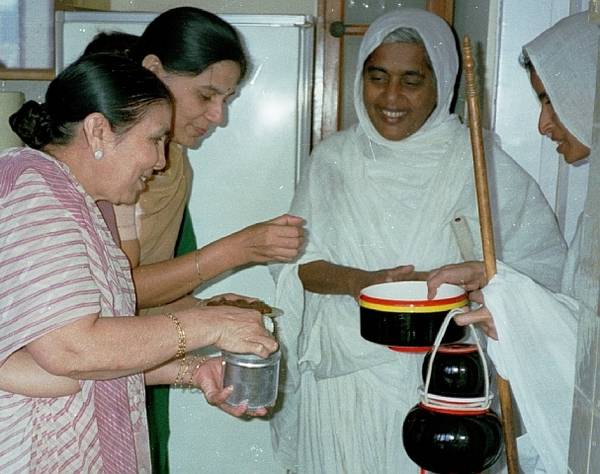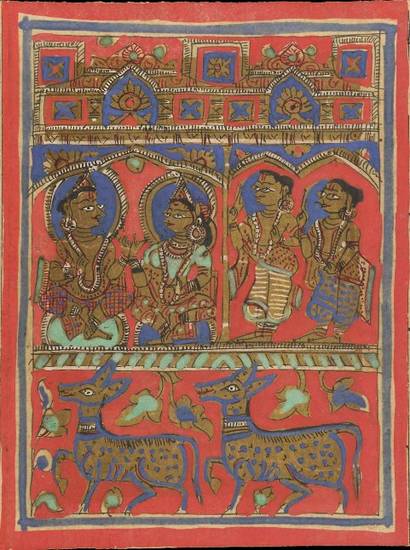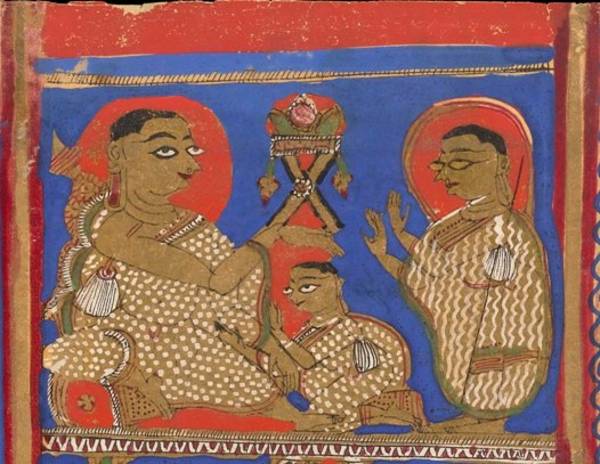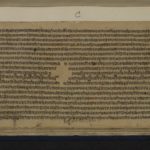Article: Mūla-sūtras
The ‘Fundamental texts’ – mūla-sūtra in Sanskrit – is the generic term that has come to be applied to certain writings in the Śvetāmbara canon. Meant to teach the basics of Jain doctrine and practice to mendicants, these form a set of works, all written in Ardhamāgadhī Prakrit. New monks and nuns begin to study these texts immediately after their initiations. The works are considered to contain the basic elements that must be understood to lead the mendicant life and therefore make up the first stage in the Śvetāmbara monastic curriculum.
Although the Mūla-sūtras deal with subjects that are partly treated in other writings in the Śvetāmbara canon, they can be viewed as being more suitable teaching texts. Among these topics are the mendicant’s way of life, his interactions with other mendicants in the context of religious hierarchy or his interactions with lay people while seeking alms. This is a recurring topic in several of the Mūla-sūtras.
Basic teaching means rules, but it also includes parables and legends. These literary forms have a prominent place in one of the Mūla-sūtras, the Uttarādhyayana-sūtra. All the Mūla-sūtras contain passages in both prose and verse. Besides the usual prescriptive style of ‘one should…’, some of the works also employ the first-person ‘I’ style, which directly involves the reader. Some passages are markedly similar or even the same as sections found in other Śvetāmbara holy texts. The last work is a set of two specialised verse commentaries relating to daily monastic life, especially alms-gathering.
The last writing has been integrated into the category of ‘fundamental texts’ by the Śvetāmbara Mūrtipūjaks, but not by the other Śvetāmbara sects. The Sthānaka-vāsins and Śvetāmbara Terāpanthins thus consider there are three Mūla-sūtras while the image-worshipping Śvetāmbaras hold there are four.
This article examines the first text – the Daśavaikālika-sūtra – in some detail and discusses the fourth Mūla-sūtra – the Piṇḍa-niryukti and Ogha-niryukti. The other two scriptures are summarised here and explored in depth in separate articles called Uttarādhyayana-sūtra and Āvaśyaka-niryukti.
Identity and status
Four works have come to be included in the Mūla-sūtra category of holy writings for Śvetāmbara Mūrtipūjaks. The Sthānaka-vāsin and Terāpanthins do not include the fourth one in lists of canonical scriptures.
|
Name in Prakrit |
Name in Sanskrit |
|
|---|---|---|
|
1 |
Dasaveyāliya-sutta |
Daśavaikālika-sūtra |
|
2 |
Uttarajjhayaṇa-sutta |
|
|
3 |
Āvassaya-sutta |
Āvaśyaka-sūtra |
|
4 |
Piṇḍa-nijjutti and Ogha-nijjutti |
Piṇḍa-niryukti and Ogha-niryukti |
The first and third scriptures have a prominent place in monastic life. These two works belong to the few canonical texts, in the strict sense, that are part of the modern monastic curriculum as defined by the Jain Mūrtipūjaka Tapāgaccha Conference of 1988 (Cort 1991: 654 and Cort 2001: 330–340).
The first Mūla-sūtra, the Daśavaikālika-sūtra, deals with proper monastic conduct. Therefore monks and nuns begin memorising it just after initiation – dīkṣā. Memorisation of the whole text is achieved in stages.
The Āvaśyaka-sūtra, the third Mūla-sūtra, is concerned with the six obligatory duties of the mendicant, in particular repentance – pratikramaṇa. New mendicants also start committing this scripture to memory immediately after their initiation.
Furthermore, Mūrtipūjaka mendicants study the second and fourth Mūla-sūtras later in their monastic training.
Mūla-sūtra 1 – fundamental teachings
Contemporary observation as well as various historical reports and accounts show that the Daśa-vaikālika-sūtra is the one learnt first by newly ordained Śvetāmbara mendicants (Illustrated Daśa-vaikālika-sūtra, Introduction page 23; Balbir 2008: 170–171). They learn it by heart before studying its meaning.
The composition of the first Mūla-sūtra is described in a legend that stresses a link with the 24th Jina Mahāvīra and the earliest summaries of his teachings, the Pūrvas. The reason given in the story for the Daśa-vaikālika-sūtra‘s creation is to pass on the teachings quickly. These two legendary elements have long bestowed authority on the scripture‘s status as the initial text from which to learn basic Jain beliefs and practices.
Mendicants often recite the first stanzas because they embody the core of Jain teaching, for instance when pouring sandalwood powder on the heads of lay followers as a form of blessing.
Traditional authorship
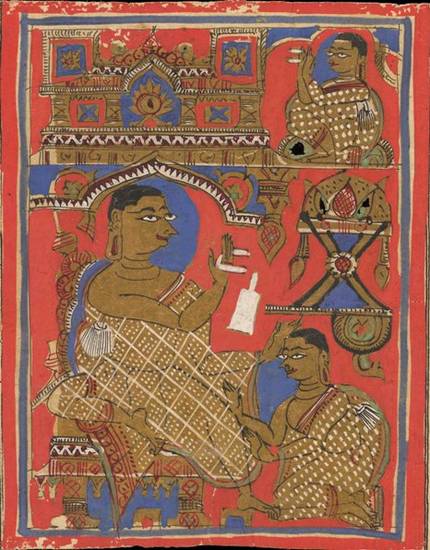
Monastic teacher
Image by British Library © CC0 1.0 (Creative Commons Public Domain)
The authorship of the Daśa-vaikālika-sūtra is inscribed within the traditional history of Śvetāmbara lineages of teachers. It is regarded as having been written by Śayyambhava, also known by his Prakrit name of Seyyambhava. He was the pupil of the teacher Prabhava, who was himself the pupil of Jambū the elder. In the traditional dating Śayyambhava became head of the monastic community Mahāvīra founded in the 75th year after Mahāvīra’s nirvāṇa, thus in 452 BCE.
Śayyambhava is said to have written the Daśa-vaikālika-sūtra for his son Maṇaka. The tale of how he came to compose it is told in the commentaries to the work and in narrative books recounting the ‘lives of the Jain elders’. Hemacandra’s version of the 12th century can be viewed as a convenient reference.
The Brahmin Śayyambhava was about to perform an animal sacrifice. The Jain teacher Prabhava sent two monks to convert him, who raised doubts in his mind as to the truth of the Veda. Śayyambhava finally recognised the truth of the Jain doctrine and practices, with non-violence at their centre. He was so convinced that he turned to the life of a Jain monk.
At the time of his decision to become a monk, Śayyambhava’s young wife was pregnant and duly gave birth to his son. As the boy Maṇaka grew up, he enquired about his father. Without his mother’s knowledge, Maṇaka went in search of him.
When he saw the boy for the first time Śayyambhava immediately recognised his son, but talked to him without disclosing his identity. As Maṇaka had said that he would be ordained as a Jain monk if he found his father, Śayyambhava introduced him to the teaching. But through the powers his great spiritual knowledge gave him, Śayyambhava realised that Maṇaka would die in six months’ time.
The great monk Śayyambhava thought, ‘This child’s life will be extremely short. How will he learn the teachings? The last Teacher who knows just ten of the fourteen Original Collections of Teachings is permitted to make an epitome of their doctrine, but for what reason may one who knows all fourteen? The reason has arisen: it’s to enlighten Maṇaka! I’ll prepare a compilation of the topics of the Original Collections of Teachings.’ When the spiritual leader Śayyambhava had finished his compilation of the Teachings, he named it the Ten Evening Chapters. The treatise is called the Ten Evening Chapters because he composed the ten chapters in an evening. Holy Śayyambhava, the excellent Teacher, the leader of the monastic order, most eminent of the compassionate, recited the treatise to Maṇaka.
The Lives of the Jain Elders, Fynes 1998: 122–123
As his father had foreseen, Maṇaka died after six months. In a later life he reached final liberation, which was said to have resulted from his learning this treatise.
Śayyambhava then expressed the wish to conceal this compilation, as he had first intended, but was then convinced by his own pupils not to do so.
The monastic community joyfully requested the religious Teacher, ‘Let this treatise which was prepared for Maṇaka, be of benefit to the whole world. Then beings who have the capacity for enlightenment, even those of little understanding, will perform their religious duty. Let them enjoy the benefits of your kindness, in the same way as Maṇaka. Like homeless bees, may they delight in continually resorting to the Ten Evening Chapters, the flower of the lotus plant of religious teaching’. Thus the monastic congregation prevented the noble religious teacher Śayyambhava from suppressing the Ten Evening Chapters.
The Lives of the Jain Elders, Fynes 1998: 124
Title of the ‘Daśavaikālika-sūtra’
The legendary account of the scripture’s creation gives the title of the work as meaning the ‘Ten Evening Chapters’ and explains it with reference to the time it was written. Another understanding of the title refers to the time when it should be read, because it may mean ‘Ten [lectures] beyond [the prescribed study hours]’. This interpretation underlines that this work can be read any time. Mention of the ‘time’ prescribed for reading refers to a method of grouping scriptures, but is not easy to interpret.
Compendium

Gallery of an Agam Mandir
Image by Nalini Balbir © Nalini Balbir
The legendary account of its composition emphasises the fact that the Daśa-vaikālika-sūtra is an abridgment of the 14 Pūrvas. Some commentators have developed this idea by making specific connections between certain chapters and given Pūrvas.
Others, however, consider that this work is an epitome of the 12 Aṅgas. Similarly, they establish a systematic connection between given chapters of the Daśa-vaikālika-sūtra and particular Aṅgas. The fact is that most of the topics the Daśa-vaikālika-sūtra covers are also dealt with in other parts of the canon, especially in the first Aṅga, the Ācārānga-sūtra, the oldest book on monastic conduct. In a number of cases these connections go beyond the contents and relate to points of detail, such as metaphors or phrases (see further Illustrated Daśavaikālika Sūtra, introduction pages 20–21).
A number of traditionally famous striking formulas or aphorisms believed to capture the essence of Jainism comes from this work.
|
Prakrit phrase (chapter and verse) |
English translation |
|---|---|
|
dhammo mangalam ukkiṭṭhaṃ (1. 1) |
‘Dharma is the best among auspicious things’ or ‘The best word to begin with is Dharma’ (Schubring) |
|
paḍhamaṃ nāṇaṃ tao dayā (4. 10) |
‘First knowledge, then compassion’ |
|
dhammassa viṇao mūlaṃ (9. 2. 2) |
‘Humble behaviour is the root of Dharma’ |
|
savve jīvā vi icchanti jīviuṃ na marijjiuṃ (6. 11) |
‘All living beings wish to live, not to die’ |
|
mucchā pariggaho vutto (6. 21) |
‘Attachment is possession’ |
Number of chapters
Ten is the number of chapters to be expected from the title, and is indeed the actual number. But it is increased by two appendices – cūlikās – following the tenth chapter. These are considered integral parts of the whole work.
|
Chapter number |
Title |
Number of stanzas |
|---|---|---|
|
1 |
Duma-pupphiyā |
5 |
|
2 |
Sāmaṇa-puvvagaṃ |
11 |
|
3 |
Khuḍḍiyāyāro |
15 |
|
4 |
Cha-jjīvaṇiyā |
prose + 29 stanzas |
|
5 – two sections |
Piṇḍesaṇā |
100 + 50 |
|
6 |
Dhammaṭṭha-kahā |
69 |
|
7 |
Vakka-suddhī |
57 |
|
8 |
Āyāra-paṇihī |
63 |
|
9 – four sections |
Viṇaya-samāhī |
17 + 23 + 15 + prose and 12 stanzas |
|
10 |
Sa-bhikkhu |
21 |
|
Appendix 1 |
Raivakka-cūliyā |
prose + 17 stanzas |
|
Appendix 2 |
Cūliyā |
16 stanzas |
As noted by some scholars, such as Schubring, the even-numbered and odd-numbered chapters deal systematically with different topics. The even-numbered chapters tend to cover mendicant lifestyle in general whereas the others deal with particular topics of monastic life.
Contents
The subject matter of the Daśa-vaikālika-sūtra is mendicant conduct, with several key aspects reiterated and expanded on throughout the chapters and appendices. These key elements of mendicant life are related to food, behaviour towards others, especially superiors and lay people, and knowledge crucial for a monk‘s proper conduct and spiritual progress. Several passages are identical or very similar to other Śvetāmbara scriptures that deal with these topics.
Chapter 1
The first chapter of the first Mūla-sūtra is brief. It underlines the idea prevailing in the whole book that a monk should live in a way that does not harm those on whom he depends, especially during his search for alms. This is expressed through a famous comparison, also found in similar terms in Buddhist scriptures. It states that the monk should be like the bee which sucks pollen from flowers without hurting them.
Chapter 2
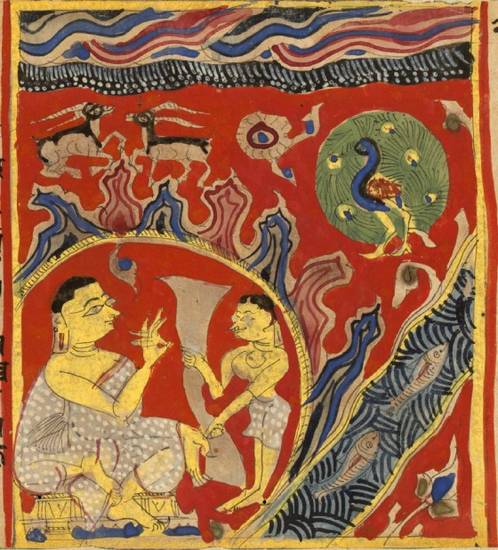
Rājīmatī and Rathanemi in the cave
Image by Victoria and Albert Museum © V&A Images/Victoria and Albert Museum, London
The Daśa-vaikālika-sūtra does not contain any narrative chapter. But the famous story featuring Rājimāti’s lesson to Rathanemi is recalled in chapter 2.
In this tale Rathanemi is so beguiled by Rājimāti’s beauty that he is about to give up life as a monk until she reminds him of his vows. The purpose of the second chapter is to strongly encourage monks to remain firm on the path of celibacy and not to indulge in desire.
The story and verses here are identical to the same episode told in chapter 22 of another Mūla-sūtra, the Uttarādhyayana.
Chapter 3
A condensed description of proper monastic conduct is the subject of chapter 3. Like several other chapters, the emphasis is on the proper way for monks to behave when in contact with lay people. Self-control and endurance are also the themes.
Chapter 4

Examples of types of living beings
Image by British Library © CC0 1.0 (Creative Commons Public Domain)
The fourth chapter of the Daśa-vaikālika-sūtra is extremely important. It starts with an extensive description of the six kinds of life forms:
- earth-bodies – puḍhavi
- water-bodies – āu
- fire-bodies – teu
- wind-bodies – vāu
- plant-bodies – vaṇassai
- mobile bodies – tasa
Exact knowledge of this topic is a prerequisite for proper monastic conduct. Such behaviour is characterised by self-control and its consequence, which is non-aggression towards living beings and non-violence. These notions are expressed by the Sanskrit terms ahiṃsā and saṃyama, which occur right at the beginning of the work.
Thus the monk is told not to:
- harm living beings
- cause others to harm them
- allow others to harm them in mind, speech or action.
Then comes the exposition of the five major vows – mahā-vratas – which define the fundamentals of monastic conduct. They are not formulated as general rules, but phrased in the first person singular as a resolution expressed in the presence of one’s teacher. This is a way to involve the reader or vow-taker directly in the process:
- I take the first great vow – abstinence from harming any living being in any way
- I take the second great vow – abstinence from wrong speech
- I take the third great vow – abstinence from taking what has not been given
- I take the fourth great vow – abstinence from sexual intercourse
- I take the fifth great vow – abstinence from keeping any possession.
To the set of the five vows is added a sixth. This vow relates to the prohibition on eating at night – that is, after sunset. This vow is not recorded in the great vows as expressed in the first Aṅga of the Śvetāmbara canon, the Ācārānga-sūtra.
Then comes another set of prose paragraphs where various prohibitions relating to monastic behaviour are expressed in general terms as ‘A monk or a nun should not…’.
This chapter ends with a set of stanzas emphasising the need for knowledge and the ability to discriminate between good and bad. The verses stress how necessary these two elements are before the monk can begin proper behaviour.
Chapter 5
In two sections, chapter 5 deals extensively with ‘the begging-tour’ or search for alms which Śvetāmbara mendicants undertake twice a day. The text stresses how precautions have to be taken regarding the:
- origin and nature of the food offered as alms
- procedure when accepting the food
- procedure when consuming it.
As the rituals surrounding the seeking, accepting and eating of food as alms are highly complex, numerous faults can be committed easily. Whereas other specialised texts on alms give technical designations and definitions, here the emphasis is on practical aspects, such as:
- what should the mendicant avoid?
- what should he do in a given circumstance?
The text refers to the circumstances where a mendicant interacts with the lay donor – the lady who cooks and provides the food.
The interpretation of particular terms used here (5. 1. 73) has been highly controversial. It is said that the monk should avoid bahu-aṭṭhiyaṃ puggalaṃ aṇimisaṃ vā bahu-kaṇṭayaṃ. In the standard Jain understanding, this means to avoid ‘fruits with many seeds, scales, thorns’. But the parallel of the phrase found in the first Aṅga, the Ācārānga-sūtra, raises difficulties with the usual interpretation. The phrase bahu-y-aṭṭhiyaṃ vā maṃsaṃ macchaṃ vā bahu-kaṇṭagaṃ (II. 1. 10. 5) is used, where the words for ‘meat’ – maṃsaṃ – and ‘fish’ – macchaṃ – are straightforward. This suggests that the meaning is ‘lump of flesh with many bone pieces’ and ‘fish with many scales and spikes’. This is one of the traces found in scriptures that indicate that non-vegetarianism was not excluded in earlier times and that ancient Jain ascetics could have eaten meat (Alsdorf-Bollée 2010: 6ff., Dundas 2002: 177). These traces can be found even though they are extremely disturbing to Jain orthodoxy and thus tend to be suppressed. Schubring’s 1932 translation of the Daśavaikālika-sūtra verse was censored by the Jain publisher (Managers of the Sheth Anandji Kalianj in Ahmedabad, Gujarat), with the controversial words appearing as ‘x x x x x’.
Chapter 6
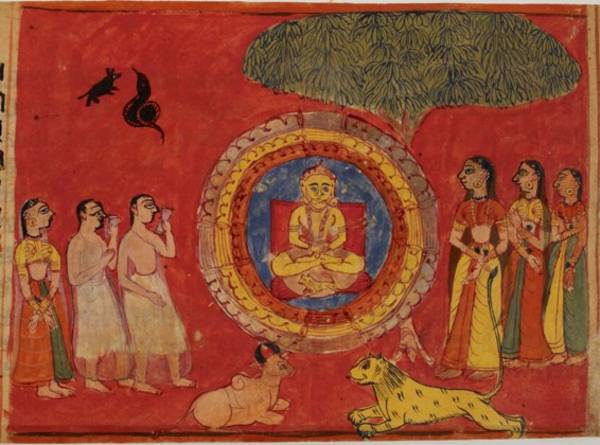
Mahāvīra and the universal gathering
Image by British Library © CC0 1.0 (Creative Commons Public Domain)
An elaborate exposition of dharma and conduct, the sixth chapter can be viewed as a longer version of what is summarised in chapter 3. It is presented in the form of a sermon given by a teacher in answer to questions about the nature of his conduct.
Some of the topics are common to other chapters, such as references to the six life forms, the great vows and searching for alms. The expounding teacher often refers to Mahāvīra as the source of his exposition and provides a strong argument in favour of saintly behaviour, which leads to perfect calmness and final liberation.
Chapter 7
The Daśa-vaikālika-sūtra’s seventh chapter is on right speech and is derived from a section on the same topic in the Ācārānga-sūtra (II. 4). Purity in speech does not just mean not lying. There is much more to it, which is detailed here.
Rough speech is also included as a type of improper speech. Examples are provided of phrases that should not be uttered because they could hurt or be misleading. Insults are one form of wrong speech, but also sentences that imply violence or could encourage it. For instance
a monk should not say of a man, a quadruped, a bird, or a snake: “He / it is big and fat and fit to be killed and cooked”. He should say: “He / it is of increased bulk, his / its body is well grown, he / it has attained a sizeable shape”
7.22–23, Schubring’s translation, page 102
The main idea is that the mendicant should:
- think before speaking
- avoid speaking if it is better not to talk
- phrase his statements extremely carefully.
Chapter 8
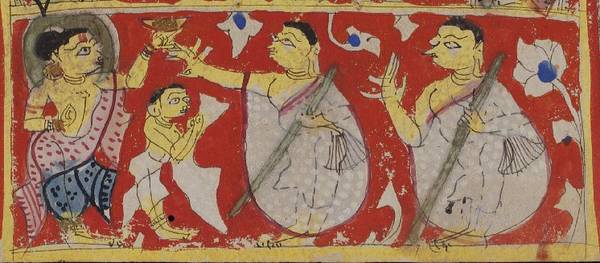
Giving alms to Śvetāmbara monks
Image by Victoria and Albert Museum © V&A Images/Victoria and Albert Museum, London
The topic of the eighth chapter is again the rules of conduct for all circumstances of monastic life. This chapter phrases these rules as either ‘the monk should…’ or ‘he should not…’.
Some rules relate to topics already dealt with in the preceding chapters, such as food or speech. The emphasis is on restraint, detachment and protection from inclinations or passions that prevent the mendicant from reaching the goal of spiritual progression to salvation. The conclusion is:
Such a monk who bears all pains, has subdued his senses, possesses knowledge of tradition, is without egotism and property, shines forth, when the cloud of Karman has disappeared, like the moon at the definitive removal of the cloudy veil
8. 63, Schubring’s translation, page 109
Chapter 9
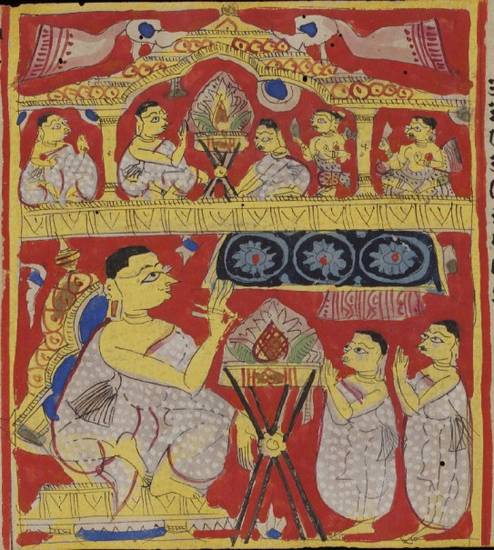
Senior monk teaching
Image by Victoria and Albert Museum © V&A Images/Victoria and Albert Museum, London
There are four sections in Chapter 9, all discussing the relationship between the mendicant and his superiors, between the student and his teacher. In order to be able to learn and progress, a mendicant must behave with modesty, humility and respect. All these notions are conveyed in one term – vinaya – which is also the topic of the first chapter of another Mūla-sūtra, the Uttarādhyayana-sūtra.
Thus a disciple should not offend or mock his teacher – guru – as the first section explains. This may have unwished for and dangerous consequences: ‘after an offence against the Guru there is no Salvation’ (9. 1. 9; Schubring’s translation, page 110).
The second section starts with the vigorous statement that ‘humble behaviour is the root of dharma’. The attitudes of respectful and arrogant monks are described and their respective results contrasted. The third section has a positive approach, concentrating on the one who is humble and well behaved. All the stanzas of this section end with the same motto, which gives the section a formal unity. The motto is: ‘he is worthy of respect’ – sa pujjo.
In the final section, four points regarding the general concept of vinaya are examined in turn, which are:
- devotion to discipline
- devotion to the sacred texts
- devotion in fasting
- devotion to good conduct.
Chapter 10
Each stanza of chapter 10 of the Daśa-vaikālika-sūtra is also characterised by a concluding refrain. This time it is: ‘he is a true monk’ – sa bhikkhū.
Here is a description of the ideal conduct of the wandering mendicant. It is written in a number of different metres. This poetical piece is similar to the 15th chapter of the Uttarādhyayana-sūtra, which has the same refrain and also uses various metres.
Appendix 1
The first appendix considers a mendicant who is disheartened and has doubts about his way of life. He is then invited to bear in mind a set of 18 statements, such as, in Schubring’s rendering:
- ‘worthless and transient are the pleasures of people who dwell in houses’
- ‘This my trouble will not last long’
- ‘If I returned to the life of a house-holder, this would be as if I swallowed my own vomit’.
Such thoughts will help him to stay on the right path. In the following verse-section they are expressed again in another form. This section also holds warnings of the negative perspectives that await him if he succumbs to the temptation to renounce monkhood.
Appendix 2
In the Daśa-vaikālika-sūtra’s second appendix, many rules set out in the previous chapters are stated again in different words. A powerful comparison is meant to stimulate one on the right path:
While most people are swimming with the current, a man who wishes to cleanse himself must oppose his body to the current and thus receive the oncoming waves. The worldly-minded people delight in swimming with the current and the reduced influence of the virtuous consists in the turning back of the flood. The current is the Saṃsāra, to pass through it is to make headaway against it
12. 2–3, Schubring’s translation, page 120
The emphasis here is on secluded life and the proper way to practise it. As in the rest of the work, one of the main points underlined is how to behave in the monk’s daily interactions with householders.
The final stanza, which is also the last of the whole text, is often quoted as summarising its general tone.
The soul must always be protected by all senses under control. An unprotected [mendicant] treads on the path of rebirth, a well-protected [one] is freed from all pain
12. 16, Schubring’s translation, page 121, slightly modified
Mūla-sūtra 2 – basic concepts and legends
The second Mūla-sūtra is called Uttarajjhayaṇa-sutta in Prakrit, Uttarādhyayana-sūtra in Sanskrit. The term uttara can be understood as meaning ‘last’, ‘additional’ or ‘excellent’. This scripture deals with all aspects of Jain doctrine and monastic practice, such as:
- detachment
- proper conduct
- karma
- colours of the soul
- detailed exposition of living beings.
These fundamental concepts are considered in 36 lessons, all characterised by forceful statements.
|
Chapter number |
Title |
English meaning or topic |
Number of stanzas |
|---|---|---|---|
|
1 |
Viṇaya-suya |
Discipline and modesty |
48 |
|
2 |
Parīsaha |
The disturbances |
prose and 48 stanzas |
|
3 |
Cāurangijja |
The ‘four mains’ |
20 |
|
4 |
Asaṃkhaya |
On carelessness and vigilance |
13 |
|
5 |
Akāma-maraṇijja |
Death of the wise and death of the fool |
32 |
|
6 |
Khuḍḍāga-niyaṇṭhijja |
The new ascetic |
17 |
|
7 |
Elaijja |
The parable of the ram |
30 |
|
8 |
Kāvilīya |
Kapila’s verses |
20 |
|
9 |
Nami-pavvajjā |
King Nami’s renunciation |
62 |
|
10 |
Duma-pattaya |
The tree leaf |
37 |
|
11 |
Bahu-ssuya |
The very learned |
32 |
|
12 |
Hariesijja |
On Harikeśa |
47 |
|
13 |
Citta-sambhūijja |
The story of Citta and Sambhūta |
35 |
|
14 |
Usuyārijja |
On Iṣukāri |
53 |
|
15 |
Sa-bhikkhuya |
The true monk |
16 |
|
16 |
Bambhacera-samāhi-ṭṭhāṇa |
The conditions of chastity |
prose and 19 stanzas |
|
17 |
Pāva-samaṇijja |
The bad ascetic |
21 |
|
18 |
Saṃjaijja |
On Sañjaya |
54 |
|
19 |
Miyāputtijja |
On Mṛgāputra |
99 |
|
20 |
Mahā-niyaṇṭhijja |
On the great ascetic |
60 |
|
21 |
Samuddapālijja |
On Samudrapāla |
24 |
|
22 |
Rahanemijja |
On Rathanemi |
49 |
|
23 |
Kesi-Goyamijja |
Keśi and Gautama |
89 |
|
24 |
Pavayaṇa-māyā |
The main articles of the doctrine |
27 |
|
25 |
Jannaijja |
On sacrifice |
45 |
|
26 |
Sāmāyārī |
53 |
|
|
27 |
Khalunkiya |
The parable of the bad bullocks |
17 |
|
28 |
Mokkha-gama-gati |
The road to emancipation |
36 |
|
29 |
Sammatta-parakkama |
The effort towards righteousness |
in prose, fairly long |
|
30 |
Tava-magga-gaijja |
The road to austerity |
37 |
|
31 |
Caraṇa-vihi |
Mode of conduct |
21 |
|
32 |
Pamāya-ṭṭhāṇa |
The causes of carelessness |
111 |
|
33 |
Kamma-payaḍī |
The varieties of karma |
25 |
|
34 |
Lesā |
The colours of the soul |
61 |
|
35 |
Aṇagāra-magga-gaīya |
The path to the life of a mendicant |
21 |
|
36 |
Jīvājīva-vibhatti |
On living and non-living |
267 |
The Uttarādhyayana-sūtra offers a combination of didactic and narrative chapters, containing numerous conversion stories. In the latter in particular, Jain values are not universally accepted and have to be demonstrated. Thus dialogues and opposing views are common in this text.
With one of the richest pictorial histories of any Śvetāmbara scripture, the Uttarādhyayana-sūtra has countless illustrations for both instruction and story approaches.
Although it has prose passages, the Uttarādhyayana-sūtra is chiefly in verse. The poetry demonstrates a range of metres, which suggest different parts of it date from various periods.
This scripture is examined in more depth in the dedicated Uttarādhyayana-sūtra article.
Mūla-sūtra 3 – six obligatory duties
Called Āvassaya-sutta in Prakrit and Āvaśyaka-sūtra in Sanskrit, the third Mūla-sūtra is also the shortest.
In its full form the Āvaśyaka-sūtra is not considered to be extremely old, but it is very important because of its subject. It deals successively with the six obligatory duties of a mendicant, centring around the idea of confession and repentance – pratikramaṇa. It is a liturgical text, containing the formulas a monk must recite in the presence of a teacher to express his wish to adopt proper conduct or to repent for transgressions. In five sections out of six, the formulas are in the first-person singular, with the ‘I’ a mendicant. Examples include:
- ‘Venerable teacher, I perform the rite of equanimity’
- ‘O teacher, I wish to pay homage / repent and so on’.
Each covering one of the obligatory duties, the six sections are in prose but contain hymns of praise in verse. These devotional songs are also part of the formalised ritual that the Āvaśyaka-sūtra unfolds.
This scripture is examined in more depth in the article on the Āvaśyaka-sūtra and its commentary, the Āvaśyaka-niryukti.
Mūla-sūtra 4 – gathering alms

Śvetāmbara monastic equipment
Image by Nalini Balbir © Nalini Balbir
This Mūla-sūtra is different from the other three works in this class of scripture in several ways.
Firstly, the Śvetāmbara sects of the Sthānaka-vāsins and Terāpanthins do not recognise this text as a Mūla-sūtra. However, Śvetāmbara Mūrtipūjak Jains class it as the fourth Mūla-sūtra. This is a way to give it more prominence, partly due to the fact that it deals at length with all issues regarding the search for alms.
Secondly, it is made up of two texts. These are known as the Piṇḍa-nijjutti and Ogha-nijjutti in Prakrit, Piṇḍa-niryukti and the Ogha-niryukti in Sanskrit.
Next, technically its constituent texts belong to another category of Jain writings – that of the niryukti. This generic name is given to a group of ten Prakrit verse-commentaries where scholastic methods of analysis are applied to understand words and concepts. The other existing texts in this category are based on a specific work – a sūtra. This is not the case with these two works, which have arisen independently of any sūtra. They are ascribed to ‘Bhadrabāhu’ or ‘Bhadrabāhu II’, who could have lived in the 1st century CE or, according to some, in the 5th century CE (Wiley 2004: 52).
More generally, the two works are related in their contents, dealing in highly technical and sophisticated ways with daily mendicant life. The Ogha-niryukti deals with various aspects, taking its title from ogha, meaning ‘general, global’. This includes the practice of gathering alms, which Śvetāmbara monks and nuns collect twice a day. The second text concentrates on the issue of alms-gathering, with piṇḍa meaning ‘rice-ball’. These complementary works also cover matters relating to the alms bowl, with the Ogha-niryukti also treating other monastic implements. They provide a lot of information about material culture, however difficult it may be to grasp (Deo 1960, Mette 1974, Bollée 1994).
Hence the Ogha-niryukti and the Piṇḍa-niryukti function as specialised supplements to matters that are especially detailed in another of the ‘Fundamental Texts’. This is the Daśa-vaikālika-sūtra, the fifth chapter of which deals with seeking, receiving and consuming alms.
The Ogha-niryukti has 812 stanzas distributed over seven sections.
|
Section |
Prakrit term |
Sanskrit equivalent |
Subject |
Stanzas |
|---|---|---|---|---|
|
1 |
paḍilehaṇā |
pratilekhanā |
inspection of:
|
1–330 |
|
2 |
piṇd’esaṇā |
piṇḍaiṣaṇā |
rituals relating to:
|
331–595 596–665 |
|
3 |
uvahi |
upadhi |
monastic equipment:
|
666–762 |
|
4 |
aṇāyayaṇa-vajja |
an-āyatana |
how to avoid making mistakes |
763–786 |
|
5 |
paḍisevaṇā |
pratisevanā |
breaking the vows |
787–790 |
|
6 |
āloyaṇā |
ālocanā |
confession and reporting any mistakes to the teacher |
791–794 |
|
7 |
sall’uddharaṇa |
śalya-uddharaṇa |
literally ‘extraction of the thorns’, purification through atonement for any mistake |
795–812 |
The sister text that also comprises the fourth text – the Piṇḍa-niryukti – has 671 verses in three large sections, corresponding to eight headings. The two writings also share numerous verses.
|
Section |
Prakrit term |
Sanskrit equivalent |
Subject |
Stanzas |
|---|---|---|---|---|
|
1 |
|
|
alms-search mistakes:
|
1–512 |
|
2 |
gav’esaṇā |
gaveṣaṇā |
improper ways of seeking alms |
513–628 |
|
3 |
ghās’esaṇā or paribhoga |
grāsaiṣaṇā or paribhoga |
mistakes relating to the consumption of food or the mode of eating |
629–671 |
Commentaries
Like other categories of the Śvetāmbara canon, the Mūla-sūtras have been the starting point of many commentaries over the centuries. All forms of Jain commentary have been applied to them, namely:
- verse commentaries in Jaina Māhārāṣṭrī Prakrit – niryuktis and bhāṣyas composed during the first centuries CE
- prose cūrṇis written in Jaina Māhārāṣṭrī Prakrit over the 6th to 7th centuries
- prose ṭīkās and vṛttis written in Sanskrit from the 8th century onwards
- later commentaries in Sanskrit or in vernacular languages.
|
Title |
Sanskrit commentaries |
||
|---|---|---|---|
|
Daśa-vaikālika-sūtra |
yes |
by Agastyasiṃha |
well-known examples by:
|
|
yes |
yes |
well-known examples by: |
|
|
Āvaśyaka-sūtra |
|
by Jinadāsa |
well-known examples by:
|
|
no |
well-known examples by:
|
The verse commentary on the third Mūla-sūtra, the Āvaśyaka-niryukti, has ‘assumed a quasi-canonical status’ (Dundas 2002: 75) owing to its large size and the way it discusses important mythological and philosophical matters.
The fourth work of the category is formed by verse texts that are not based on any sutra. This probably explains why the Sthānaka-vāsins and the Terāpanthins do not regard the Piṇḍa-niryukti and Ogha-niryukti as canonical scriptures.
Reading
- Jaina Studies: Their Present State and Future Tasks
Ludwig Alsdorf - translated by Bal Patil
edited by Willem Bollée
Hindi Granth Karyalay; Mumbai, Maharashtra, India; 2006
- The Āryā Stanzas of the Uttarajjhāyā: Contributions to the Text History and Interpretation of a Canonical Jaina Text
Ludwig Alsdorf - Abhandlungen der Geistes- und Sozialwissenschaftlichen Klasse series; volume 2
Akademie der Wissenschaften und der Literatur Mainz; Wiesbaden, Hesse, Germany; 1966
- The History of Vegetarianism and Cow-Veneration in India
Ludwig Alsdorf - translated by Bal Patil
edited by Willem Bollée
Routledge Advances in Jaina Studies series; series editor Peter Flügel; volume 3
Routledge Curzon Press; London, UK; 2010
- Kleine Schriften
Walther Schubring - edited by Klaus Bruhn
Glasenapp Stiftung series; volume 13
Franz Steiner Verlag GmbH; Wiesbaden, Hesse, Germany; 1977
- Āvaśyaka-Studien: Introduction générale et traductions
Nalini Balbir - Alt- und Neu-Indische Studien series; volume 45: 1
Franz Steiner Verlag; Stuttgart, Baden-Württemberg, Germany; 1993
- ‘Autobiographies of Jain Monks and Nuns in the 20th Century: A Preliminary Essay’
Nalini Balbir - Jaina Studies
edited by Colette Caillat and Nalini Balbir
Papers of the XIIth World Sanskrit Conference series; series editor Petteri Koskikallio and Asko Parpola; volume 9
Motilal Banarsidass; Delhi, India; 2008
- ‘Les lecteurs jaina śvetāmbara face à leur canon’
Nalini Balbir - Ecrire et transmettre en Inde classique
edited by Gérard Colas and Gerdi Gerschheimer
Études thématiques series; volume 23
École Française d’Extrême Orient; Paris; 2009
- ‘On the role and meaning of the Śvetāmbara canon in the history of Jainism’
Nalini Balbir - Studies in Jaina History and Culture: Jaina Law
edited by Peter Flügel
Routledge Advances in Jaina Studies series; volume 4
Routledge Curzon Press; London, UK; 2013 – forthcoming
- ‘Old texts, new images: Illustrating the Śvetāmbara Jain Āgamas today’
Nalini Balbir - In the Shadow of the Golden Age
edited by Julia A. B. Hegewald
University of Bonn Press; Bonn, North Rhine-Westphalia, Germany; 2012
- Materials for an Edition and Study of the Piṇḍa- and Oha-nijjuttis of the Śvetâmbara Jain Tradition
Willem B. Bollée - Beiträge zur Südasienforschung, Südasien-Institut, Universität Heidelberg series; volume 2
Franz Steiner Verlag; Stuttgart, Baden-Württemberg, Germany; 1994
- ‘The Recent Critical Editions of the Jain Āgama’
Colette Caillat - Zeitschrift der Deutschen Morgenländischen Gesellschaft
volume 21: supplement 5
F. Steiner; 1980
- ‘Notes sur les variantes dans la tradition du Dasaveyāliya-sutta’
Colette Caillat - Indologica Taurinensia
volume 8–9
International Association of Sanskrit Studies; 1980–81
- ‘The beating of the brahmins (Uttarādhyayana 12)’
Colette Caillat - Festschrift Klaus Bruhn zur Vollendung des 65 Lebensjahres
edited by Nalini Balbir and Joachim K. Bautze
Dr Inge Wezler; Reinbek, Schleswig-Holstein, Germany; 1994
- In Search of the Original Ardhamāgadhī
N. M. Kansara - translated by K. R. Chandra
Prākrt̥a Grantha Pariṣad series; volume 35
D. M. Prakrit Text Society; Ahmedabad, Gujarat, India; 2001
- The Uttarādhyayanasūtra: being the first Mūlasūtra of the Śvetāmbara Jains
Jarl Charpentier - Archives d'études orientales series; volume 18
Appelbergs Boktryckeri Aktiebolag; Uppsala, Sweden; 1922
- ‘The Śvetāmbara Mūrtipūjak Jain Mendicant’
John Cort - Man (New Series)
volume 29: 4
Royal Anthropological Institute of Great Britain and Ireland; 1991
- ‘The Intellectual Formation of a Jain Monk: A Śvetāmbara Monastic Curriculum’
John E. Cort - Journal of Indian Philosophy
volume 29
2001
- History of Jaina Monachism from Inscriptions and Literature
Shantaram Bhalchandra Deo - Deccan College Dissertation series; volume 17
Deccan College Postgraduate and Research Institute; Pune, Maharashtra, India; 1956
- ‘Somnolent Sūtras: Scriptural Commentary in Śvetāmbara Jainism’
Paul Dundas - Journal of Indian Philosophy
volume 25
1996
- The Jains
Paul Dundas - Library of Religious Beliefs and Practices series; series editor John Hinnels and Ninian Smart; volume 14
Routledge Curzon Press; London, UK; 2002
- History, Scripture and Controversy in a Medieval Jain Sect
Paul Dundas - Routledge Advances in Jaina Studies series; series editor Peter Flügel; volume 2
Routledge Curzon Press; London, UK; 2007
- Kleine Schriften
Walther Schubring - edited by Klaus Bruhn
Glasenapp Stiftung series; volume 13
Franz Steiner Verlag GmbH; Wiesbaden, Hesse, Germany; 1977
- Scripture and Community: Collected Essays on the Jains
Kendall W. Folkert - edited by John E. Cort
Studies in World Religions series; volume 6
Center for the Study of World Religions, Harvard University & Scholars Press; Atlanta, Georgia, USA; 1993
- The Lives of the Jain Elders
Hemacandra - translated and edited by R. C. C. Fynes
Oxford World’s Classics series
Oxford University Press; Oxford, UK and New York, USA; 1998
- The Jaina Path of Purification
Padmanabh S. Jaini - University of California Press; Berkeley, California USA; 1979
- Piṇḍ’esaṇā: Das Kapitel der Oha-nijjutti über den Bettelgang
Adelheid Mette - Abhandlungen der Geistes- und Sozialwissenschaftlichen Klasse series; volume 11
Akademie der Wissenschaften und der Literatur Mainz; Wiesbaden, Hesse, Germany; 1973
- The Doctrine of the Jainas: Described after the Old Sources
Walther Schubring - translated by Wolfgang Bühlen
edited by Satya Ranjan Banerjee
Lala Sunder Lal Jain Research series; volume 15
Motilal Banarsidass; New Delhi, India; 2000
- The Unknown Pilgrims: The voice of the sādhvīs – the history, spirituality, and life of the Jaina women ascetics
N. Shāntā - translated by Mary Rogers
Sri Garib Dass Oriental series; volume 219
Sri Satguru Publications; New Delhi, India; 1997
- The “Śvetāmbara Canon.” A Descriptive Listing of Text Editions, Commentaries, Studies and Indexes: Based on Editions held in the Library of the Australian National University
Royce Wiles - unpublished; Canberra, Australia; 1997
- ‘The First Collected Edition of Śvetāmbara Jain Canonical Texts’
Royce Wiles - Studia Indologica: Professor Satya Ranjan Banerjee Felicitation Volume
edited by Jagat Ram Bhattacharyya
Eastern Book Linkers; Delhi, India; 2007
- Historical Dictionary of Jainism
Kristi L. Wiley - Historical Dictionaries of Religions, Philosophies, and Movements series; series editor Jon Woronoff; volume 53
Scarecrow Press; Maryland, USA; 2004
- Jaina Yoga: A Survey of the Mediaeval Śrāvakācāras
Robert Williams - London Oriental series; volume XIV
Oxford University Press; London, UK; 1963
Links
- Bodleian Library
-
The Bodleian Library is part of the University of Oxford, the official university library with various specialist libraries. It boasts extremely extensive collections of books, newspapers, magazines, journals, manuscripts, maps, musical scores, and official and personal papers, both ancient and modern. With large Jain holdings, the Bodleian is a JAINpedia partner.
- British Library
-
One of the JAINpedia partners, the British Library is the national library of the UK. Based in London, it holds millions of historical and contemporary documents of all kinds, including books, newspapers, magazines, journals, manuscripts, musical scores and political and personal papers and letters. It also has a large collection of sound recordings and illustrations. Its collection of Jain manuscripts is one of the biggest outside India.
- Victoria and Albert Museum
-
The V&A in London specialises in art and design. Its enormous collections include historical and contemporary sculptures, textiles, furniture, jewellery, photographs, drawings, books, prints, ceramics, glass- and metalwork, theatre and performance artefacts. It has extensive Asian holdings, including many illustrated Jain manuscripts, and is one of the JAINpedia partners.
- Wellcome Collection
-
Part of the Wellcome Institute, the Wellcome Collection is one of the JAINpedia partners. Its extensive collections include historical and contemporary books, manuscripts, prints, paintings, photographs and films, with a bias towards science and medicine. The Wellcome holdings of Jain materials are small but valuable and interesting.
- Jain eLibrary
-
The Jain eLibrary provides PDFs or other files of Jain texts to download for non-commercial purposes. Scriptures, commentaries, dictionaries, articles, magazines and books on all aspects of Jainism are available in many languages, including English and modern Indian languages. Most sects are represented and both ancient and contemporary works are included.
Only registered users who have signed into the site can download material. To register, you must provide a valid email address, a password and some personal details.
You will need to have Adobe Acrobat Reader on your computer to open PDF files.
- Centre of Jaina Studies, SOAS
-
The Centre of Jaina Studies at the School of Oriental and African Studies (SOAS) in the University of London, is the only academic centre specialising in Jain research outside India. Established in 2004, the centre hosts an annual conference for scholars of Jainism and publishes an annual newsletter and the International Journal of Jaina Studies (Online). It also runs undergraduate and postgraduate degrees in Jain studies.
- Royal Asiatic Society
-
Based in London, the Royal Asiatic Society of Great Britain and Ireland dates back to 1823, when it was founded to assist scholarly investigation into the history, cultures, religions and languages of Asia. The society has a large library, including an extensive manuscript collection, organises seminars and lectures, and publishes a journal three times a year.
- Bhogilal Leherchand Institute of Indology
-
The Bhogilal Leherchand Institute of Indology in New Delhi focuses on scholarly research into Śvetāmbara Jainism. With a library of manuscripts for research, it organises academic seminars and publishes scholarly books.
- Institut Français de Pondichéry
-
The French Institute of Pondicherry is a research centre of the French Ministry of Foreigh Affairs. Founded in 1955, it undertakes scholarly research and training in South and South-East Asia. The website is in English.
- Lalbhai Dalpatbhai Institute of Indology and Museum
-
Based in Ahmedabad, Gujarat, the Lalbhai Dalpatbhai Institute of Indology is a national centre affiliated to the National Mission for Manuscripts. With a library of manuscripts, it has a specific section for manuscript preservation and cataloguing. In addition to holding seminars for researchers into Śvetāmbara Jainism, the L. D. Institute publishes books and the Sambodhi journal in English, Hindi and Gujarati. The L. D. Museum, on the same site, holds an important collection of Jain artefacts – statues, manuscripts, the N. C. Mehta Collection of paintings and a gallery of monastic equipment that belonged to Muni Puṇyavijaya.
- Mahavir Aradhana Kendra – institute
-
Based around the pilgrimage site of Mahaviralaya – a temple dedicated to Mahāvīra, the last Jina – Mahavir Aradhana Kendra is a manuscript library and research institute, which publishes academic books, chiefly on Śvetāmbara Jainism. There is also a museum that includes the monastic equipment used by Gacchādhipati Ācārya Śrī Kailāsaāgara-sūrīśvara Mahārāj.
- Parshvanath Vidyashram Research Institute
-
The Parshvanath Vidyashram Research Institute focuses on research into Śvetāmbara Jainism. Based in Varanasi, in Uttar Pradesh, it has a manuscript library and publishes books and the Śramaṇ journal in Hindi and English.
- Indian universities with departments of Jain studies
-
Jainworld provides a list of Indian universities that have departments with researchers in or courses investigating aspects of Jainism.
- Jain research institutions in India
-
Jainworld provides a list of research institutions in India that focus on various aspects of Jainism.
- Jain Vishva Bharati University
-
Located in Ladnun, Rajasthan, the Jain Vishva Bharati University is closely associated with the Terāpanthin monastic order. It also offers programmes in academic fields besides Jain studies.
- Jain studies at Claremont Lincoln University
-
Enrolling students from 2011, Claremont Lincoln University in California, USA, focuses on the academic study of religions. It offers a programme of Jain studies in partnership with Jain organisations based primarily in North America.
- Centre of Jaina Studies Newsletter
-
The Centre of Jaina Studies in the School of Oriental and African Studies (SOAS), at the University of London, publishes an annual newsletter, which is available to download as a PDF. The newsletter features:
- articles
- summaries of research
- academic news
- book reviews
- reports of exhibitions
- otifications and reports of conferences and symposia.
You will need to have Adobe Acrobat Reader on your computer to open PDF files.
- Institute of Oriental Manuscripts
-
Based in St Petersburg, the Institute of Oriental Manuscripts holds 150 Jain manuscripts. The website gives full information in English about the history and work of this research institute, part of the Russian Academy of Sciences.
http://www.orientalstudies.ru/eng/index.php?option=com_content&task=view&id=46&Itemid=82
- +
- aAbhavya
- aAbhinandana
- aAbhiṣeka
- aĀcāra
- aĀcārāṅga-sūtra
- aĀcārya
- aAchalbhrata
- aAḍhāī-dvīpa
- aAdharma
- aAdho-loka
- aAdhyayana
- aAdvaita Vedānta
- aĀgama
- aAghātīya
- aAghātīya-karman
- aAgnibhuti
- aAgra
- aĀhāra
- aAhiṃsā
- aAhimsa Day
- aAjita
- aAjīva
- aAkampit
- aĀkāśa
- aAkbar the Great
- aAkṣaya-tṛtīyā
- aAlauddin Khalji
- aAlbert Einstein
- aAllah
- aAlms
- aĀlocanā
- aAloka-ākāśa
- aAmāri
- aAmbikā or Kūṣmāṇḍinī
- aAnagāra
- aAnanta
- aAnarthadaṇḍa
- aAnaśana
- aAnekānta-vāda
- aAṅga
- aAniconism
- aAnojjā
- aAntarāla
- aAntarāya-karma
- aAṇu
- aAṇu-vrata
- aAnukampā
- aAnuprekṣā
- aAnusvāra
- aApabhraṃśa
- aAparigraha
- aAra
- aĀrambha
- aĀrambhaja
- aĀratī
- aArdhamāgadhī Prākrit
- aArhaṃ
- aArhat
- aArśana-āvaraṇīya-karma
- aĀrta-dhyāna
- aĀryikā
- aĀryikā Jñānamati
- aĀśātanā
- aĀścarya
- aAscetic
- aAsceticism
- aAshram
- aAspiration
- aĀsrava
- aAṣṭa-maṅgala
- aAṣṭāpada
- aAstikāya
- aAstrolabe
- aAsura
- aAtheism
- aAticāra
- aAtiśayakṣetra
- aAtithisaṃvibhāgavrata
- aĀtma-vāda
- aĀtman
- aAuṃ
- aAurangzeb
- aAuspicious
- aAusterity
- aAvadhāna
- aAvadhi-jñāna
- aĀvaraṇī-yakarman
- aAvasarpiṇī
- aAvatāra
- aAvidyā
- aAxiom
- aĀyāga-paṭa
- aĀyambil
- aĀyu-karma
- aĀyurveda
- bBabur
- bBāhubali
- bBaladeva
- bBālāvabodha
- bBandha
- bBasadi
- bBazaar
- bBhadrankarvijay
- bBhagavant
- bBhaktāmara-stotra
- bBhakti
- bBhale
- bBharata
- bBhāṣā
- bBhāṣya
- bBhaṭṭāraka
- bBhāva
- bBhāva-pūjā
- bBhāvanā
- bBhavana-vāsin
- bBhavya
- bBhavyatva
- bBhaya
- bBhoga-bhūmi
- bBhogopabhoga
- bBodhi
- bBollywood
- bBrahmā
- bBrahma-deva
- bBrahmacārī
- bBrāhmaṇa
- bBraj Bhāṣā
- bBright fortnight
- bBritish Raj
- bBuddha
- bBuddhi-sagar
- bBuddhism
- bBuddhist
- cCaitya
- cCaityavāsin
- cCakravartin
- cCakreśvarī
- cCāmara
- cCandanā
- cCandragupta
- cCandraprabha
- cCanon
- cCāritra
- cCāritramohanīya-karman
- cCarũrī
- cCaste
- cCaturvidha-saṅgha
- cCaturviṃśati-stava
- cCāturyāma
- cCE
- cCelibacy
- cCha
- cChadmastha
- cChastity
- cCheda-sūtra
- cChristian
- cChristianity
- cClergy
- cCloning
- cColophon
- cCommentary
- cConch
- cConfession
- cCongregation
- cConsecration
- cCosmology
- cCremation
- cCrore
- cCult
- cCūrṇi
- dDādā-guru
- dDalit
- dDāna
- dDaṇḍa
- dDark fortnight
- dDarśana
- dDarśanamohanī-yakarman
- dDaśa-lakṣaṇa-parvan
- dDeity
- dDelhi Sultanate
- dDerāsar
- dDeśāvakāśika-vrata
- dDetachment
- dDevanāgarī
- dDevānandā
- dDevarddhi-gani
- dDevotee
- dDhamal
- dDhanuṣ
- dDhāra
- dDharma
- dDharma-dhyāna
- dDharma-sāgara
- dDharmastikaya
- dDhātakīkhaṇḍa
- dDholak
- dDhyāna
- dDiaspora
- dDig-vrata
- dDigambara
- dDīkṣā
- dDisciple
- dDīvālī
- dDivya-dhvani
- dDNA
- dDoctrine
- dDogma
- dDonor
- dDoṣa
- dDravya
- dDravya-pūjā
- dDrone
- dDuṣamā
- dDuṣamā-duṣamā
- dDuṣamā-suṣamā
- dDveṣa
- dDvīpa
- eEast India Company
- eEightfold Path
- eEkānta-vāda
- eEkendriya
- eElder
- eElders
- eEschatology
- eEtc up to
- fFarmān
- fFast
- fFatehpur Sikri
- fFestival
- fFestschrift
- fFiruz Shah
- fFly-Whisks
- fFolio
- fFour Noble Truths
- gGaccha
- gGaṇa
- gGaṇadhara
- gGanadharavada
- gGaṇeśa
- gGaṇin
- gGarba
- gGarbha
- gGarbha-gṛha
- gGaruḍa
- gGati
- gGene
- gGenomics
- gGhātī-yakarman
- gGhātīya
- gGhaznavid
- gGhiyasuddin Tughlaq
- gGhurid
- gGloss
- gGotra-karma
- gGujarāt
- gGujarati
- gGuṇa
- gGuṇa-sthāna
- gGuṇa-vrata
- gGupti
- gGuru
- gGuruṇī
- hHagiography
- hHajj
- hHaṃsa
- hHaribhadra
- hHariṇaigameṣin
- hHasta
- hHeresy
- hHiṃsā
- hHindi
- hHindu
- hHinduism
- hHīravijaya
- hHoroscope
- hHrīṃ
- hHumayun
- hHymn
- iIconoclasm
- iIconography
- iIdol
- iIndian Independence
- iIndology
- iIndra
- iIndrabhūti Gautama
- iIndriya
- iInitiation
- iIntercession
- iInvocation
- iIQ
- iIslam
- iIslamicate
- iIṣṭadevatā
- iĪśvara
- jJagat
- jJahangir
- jJain
- jJaina Devanāgarī
- jJaina Śaurasenī
- jJaina-dharma
- jJainaśāsana
- jJainness
- jJaisalmer
- jJamāli
- jJambū-dvīpa
- jJames Burgess
- jJanma
- jJanma-kalyāṇa
- jJarā
- jJāti
- jJina
- jJina-āgama
- jJina-bhavana
- jJina-bimba
- jJina-mātā
- jJinacandra-sūri
- jJinadatta
- jJinaprabha
- jJīva
- jJñāna
- jJñāna-āvaraṇīya-karma
- jJñāna-āvarṇiya
- jJñānsundar
- jJyotiṣka
- kKāla
- kKālakācārya-kathā
- kKālidāsa
- kKalpa-sūtra
- kKalpa-vṛkṣa
- kKalyāṇaka
- kKalyanvijay
- kKamaṇḍalu
- kKamaṭha
- kKarma
- kKarma-bhūmi
- kKarma-grantha
- kKarma-prakṛti
- kKarma-vāda
- kKarmon
- kKarnataka
- kKaṣāya
- kKathā
- kKāvya
- kKāya
- kKāyotsarga
- kKeśa-loca
- kKetu
- kKevala-jñāna
- kKevalin
- kKhalji
- kKharatara-gaccha
- kKnowledge
- kKriyā
- kKriyā-vāda
- kKṛṣṇa
- kKṣamā-śramaṇa
- kKṣapakaśreṇi
- kKṣatriya
- kKṣullaka
- kKulakara
- kKundakunda
- kKunthu
- lLabdhi
- lLaity
- lLakh
- lLāñchana
- lLands of Action
- lLaukāntika
- lLavaṇa-samudra
- lLeśyā
- lLiṅga
- lLinguistics
- lLoka
- lLoka-ākāśa
- lLoka-puruṣa
- lLoka-vāda
- lLotus
- lLotus lake
- mMadhya-loka
- mMahā-videha
- mMahā-vrata
- mMahābhārata
- mMahāmastakābhiṣeka
- mMāhārāṣṭra
- mMāhārāṣṭrī Prākrit
- mMahattarā Yākinī
- mMahāvīr Jayantī
- mMahāvīra
- mMakāra
- mMakkhali Gośāla
- mMalli
- mMāna-stambha
- mManaḥ-paryāya-jñāna
- mMaṇḍala
- mMaṇḍapa
- mMandit
- mMaṅgala
- mMantra
- mMantras
- mManuṣya-loka
- mMarāṭhī
- mMārgaṇā
- mMartyr
- mMarudevī
- mMaṭha
- mMati-jñāna
- mMauryaputra
- mMecca
- mMendicant lineage
- mMetarya
- mMiracle
- mMithyādṛṣṭi
- mMohandas Gandhi
- mMohanīya-karma
- mMokṣa
- mMonastic order
- mMonasticism
- mMonk
- mMonotheism
- mMosque
- mMount Meru
- mMount Sammeta
- mMṛgāvatī
- mMughal
- mMuhammad
- mMuhammad bin Tughlaq
- mMuhpattī
- mMūla-sūtra
- mMūlaguṇa
- mMumbaī
- mMuni
- mMunisuvrata
- mMurad Bakhsh
- mMūrti-pūjaka
- mMuslim
- mMysticism
- nNābhi
- nNāga-kal
- nNāgapurīya Tapā-gaccha
- nNāgarī
- nNāma-karma
- nNamaskāra-mantra
- nNami
- nNandīśvara-dvīpa
- nNandivardhana
- nNandyāvarta
- nNāraka
- nNāraki
- nNasalisation
- nNātha
- nNavrātrī
- nNaya-vāda
- nNemi
- nNidāna
- nniggaṃthāṇa vā 2
- nniggaṃtho vā 2
- nNigoda
- nNihnava
- nNikṣepa
- nNirgrantha
- nNirjarā
- nNirvāṇa
- nNiryukti
- nNiṣidhi
- nNitya
- nNiyati
- nNo-kaṣāya
- nNudity
- nNun
- oOcean of milk
- oOmniscience
- oOrdination
- ppa°
- pPadmaprabha
- pPadmāsana
- pPadmāvatī
- pPādukā
- pPalanquin
- pPalette
- pPañca-muṣṭi
- pPāṇḍava
- pPaṇḍit
- pPandit Dalsukh D. Malvania
- pPandit Sukhlalji
- pPāṇipātra
- pPāpa
- pParamātman
- pParameṣṭhin
- pPāraṇā
- pParigraha
- pPariṇāma
- pParīṣaha
- pParokṣa
- pPārśva
- pPārśvanātha
- pParyāya
- pParyuṣaṇ
- pPaṭa
- pPatan
- pPātra
- pPenance
- pPersian
- pPhala
- pPhilology
- pPicchikā
- pPilgrimage
- pPīr
- pPolymath
- pPoṣadha
- pPossession
- pPothī
- pPrabhas
- pPradakṣiṇā
- pPradeśa
- pPrākāra
- pPrakīrṇaka-sūtra
- pPrākrit
- pPramāda
- pPramukhā
- pPrati-vāsudeva
- pPratikramaṇa
- pPratimā
- pPratiṣṭhā
- pPratyākhyāna
- pPratyakṣa
- pPravacana
- pPrāyaścitta
- pPrayer
- pPre-modern
- pPreach
- pPredestination
- pProtestant
- pProvenance
- pPudgala
- pPūjā
- pPujārī
- pPukharavara-dvīpa
- pPuṇya
- pPūrva
- pPuṣkara-dvīpa
- pPuṣpadanta
- pPyre
- qQur’an
- rRāga
- rRāhu
- rRainy season
- rRajasthan
- rRajasthani
- rRājimatī
- rRajoharaṇa
- rRajput
- rRāma
- rRāmāyaṇa
- rRangoli
- rRās-garbā
- rRasa
- rRathanemi
- rRatna-traya
- rRātri-bhojana
- rRaudra-dhyāna
- rRecto
- rRelic
- rRenunciation
- rRetroflex
- rRevatī
- %Ṛg-veda
- rRite
- rRosary
- %Ṛṣabha
- %Ṛṣabhanātha
- rRupee
- sSaciyā Mātā
- sSādhu
- sSādhvī
- sSāgāra
- sSaint
- sŚaivaism
- sŚaka-saṃvat
- sSallekhanā
- sŚalya
- sSamacatuṣṭha
- sSamādhimaraṇa
- sSamaṇi
- sSāmarambha
- sSamavasaraṇa
- sSāmāyika
- sSaṃbhava
- sSamiti
- sSaṃjñā
- sSaṃkalpaja
- sSaṃsāra
- sSamudghāta
- sSaṃvara
- sSaṃvega
- sSamyak-cāritra
- sSamyak-darśana
- sSamyak-jñāna
- sSamyaktva
- sSaṃyama
- sSanctuary
- sSandalwood
- sSaṇgha
- sSanskrit
- sSant
- sŚānti
- sSapta-bhaṅgi-naya
- sSārambha
- sSarasvatī
- sSarvajña
- sSāsan-devi
- sŚāsana-devatā
- sŚāstra
- %Ṣaṭ-jīvanikāya
- sSatī
- sSatīmātā
- sSatya
- sSchism
- sScribe
- sScripture
- sSect
- sSecularism
- sŚenāī
- sSermon
- sŚeṣavatī
- sSevā
- sSeven fields of donation
- sShah Jahan
- sShantidas Jhaveri
- sShrine
- sSiddha
- sSiddha-śilā
- sSiddhacakra or Navadevatā
- sSiddhānta
- sSiddhārtha
- sSiddhi
- sSikh
- sSikhism
- sŚikṣā-vrata
- sŚīla
- sSin
- sSindh
- sŚītala
- sŚiva
- sSkandha
- sSomanatha
- sŚraddhā
- sŚramaṇa
- sŚrāvaka
- sŚrāvakācāra
- sŚrāvikā
- sŚreyāṃsa
- sŚrī
- sŚrīvatsa
- sŚruta-jñāna
- sŚruta-pañcamī
- sSthānaka-vāsin
- sSthāpanācārya
- sSthāvara
- sSthavira
- sSthiti
- sStrīmukti
- sStūpa
- sSubcontinent
- sSudarshana
- sŚuddhi
- sSudharma
- sŚūdra
- sSufism
- sSukha
- sŚukla-dhyāna
- sSulasā
- sSultan
- sSumati
- sSundarśrī
- sSupārśva
- sSūri
- sSuṣamā
- sSuṣamā-duṣamā
- sSuṣamā-suṣamā
- sSūtra
- sSuyam me ausam! Tenam bhagavaya evamakkhayam
- sSvādhyāya
- sSvāhā
- sSvastika
- sŚvetāmbara
- sŚvetāmbara Terāpanthin
- sŚvetāmbaras
- sSwan
- sSyād-vāda
- tTabla
- tTantra
- tTapā-gaccha
- tTapas
- tTāraṇ Svāmī Panth
- tTattva
- tTattvārtha-sūtra
- tTemple
- tTemple-city
- tThe Enlightenment
- tTheology
- tThree worlds
- %Ṭīkā
- tTilaka
- tTīrtha
- tTīrthaṃkaranāma-karman
- tTīrthankara
- tTransliteration
- tTrasa
- tTrasa-nāḍī
- tTriśalā
- tTriṣaṣṭi-śalākā-puruṣa-caritra
- tTti bemi
- tTughlaq
- tTunk
- uUdumbara
- uUniversal History
- uUpādhyāya
- uUpāṅga
- uUpaniṣads
- uUpāsaka
- uUpasarga
- uUpāśraya
- uŪrdhva-loka
- uUtsarpiṇī
- uUttarādhyayana-sūtra
- vVāhana
- vVaimānika
- vVairāgya
- vVaiṣṇava
- vVaiśramaṇa
- vVaiśya
- vValabhī
- vVanaspatikāya
- vVandana
- vVaṇik
- vVarṇa
- vVāsudeva
- vVāsupūjya
- vVayubhūti
- vVeda
- vVedanīya-karma
- vVegetarianism
- vVehicle
- vVernacular
- vVerso
- vVidyā
- vVidyā-devī
- vVihāra
- vVijñapti-patra
- vVikrama-saṃvat
- vVikṛti
- vVimala
- vVinaya
- vVipāka
- vVirji Vora
- vVirodhaja
- vVīrya
- vVisarga
- vViṣṇu
- vVītarāga
- vVizier
- vVotive
- vVow
- vVrata
- vVS
- vVyakta
- vVyantara
- vVyasana
- yYakṣa
- yYakṣī
- yYantra
- yYaśoda
- yYaśovijaya
- yYati
- yYātrā
- yYoga
- yYoginī
- yYojana


